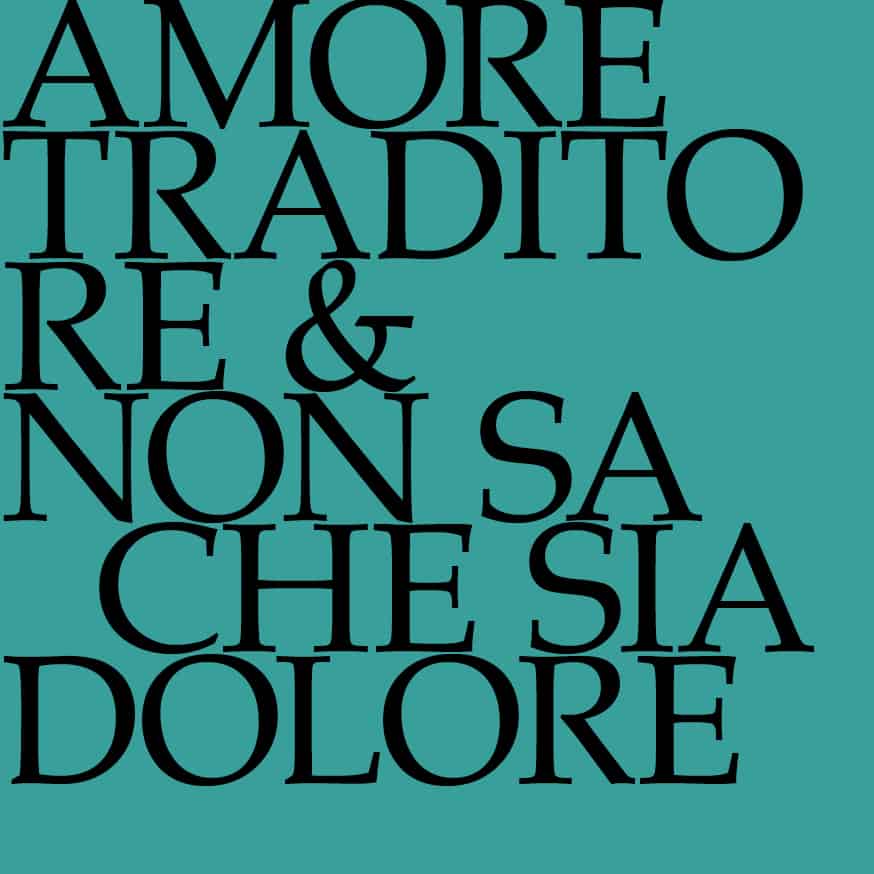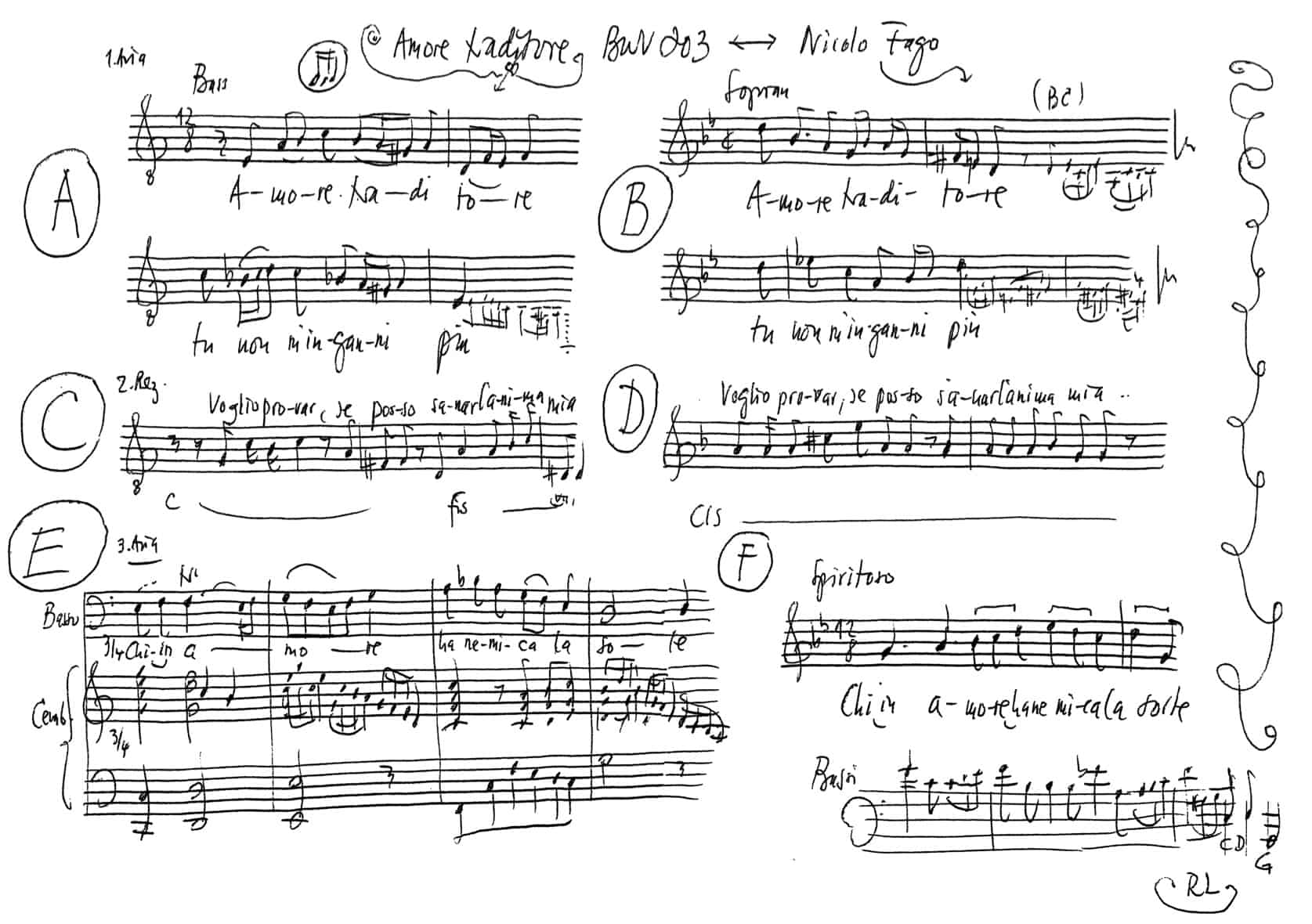Non sa che sia dolore
BWV 209 // saecular cantata
For soprano, transverse flute, strings and basso continuo

Das Werk im Kirchenjahr
Perikopen zum Sonntag
Perikopen spiegeln die biblischen Lesungen des jeweiligen Kirchensonntags wider, für den J. S. Bach komponierte. Weitere Infos zu Perikopen
Would you like to enjoy our videos ad-free? Subscribe to YouTube Premium now...
Workshop
Reflective lecture
Orchestra
Conductor & Harpsichord
Rudolf Lutz
Violin
Eva Borhi, Peter Barczi
Viola
Martina Bischof
Violoncello
Maya Amrein
Violone
Markus Bernhard
Transverse flute
Marc Hantaï
Musical director & conductor
Rudolf Lutz
Workshop
Participants
Rudolf Lutz, Alice Borciani, Maya Amrein, Johannes Lang, Dominik Wörner
Reflective lecture
Speakers
Johannes Lang
Recording & editing
Recording date
24/06/2022
Recording location
Rorschach SG (Schweiz) // Würth-Haus
Sound engineer
Stefan Ritzenthaler
Producer
Meinrad Keel
Executive producer
Johannes Widmer
Production
GALLUS MEDIA AG, Schweiz
Producer
J.S. Bach-Stiftung, St. Gallen, Schweiz
Librettist
“First performance
After 1729 — Leipzig
Text
Librettist unknown, text partly based on poems by Giovanni Battista
Guarini (1598) and Pietro Metastasio (1722/1729)”
Libretto
1. Sinfonia
2. Rezitativ — Sopran
Non sa che sia dolore
chi dall’amico suo parte e non more.
Il fanciullin’ che plora e geme
ed allor che più ei teme,
vien la madre a consolar.
Va dunque a cenni del cielo,
adempi or di Minerva il zelo.
2. Rezitativ — Sopran
Nicht weiss, was Schmerz sei,
wer von seinem Freunde scheidet und nicht stirbt.
Das Knäblein, das weint und stöhnt,
und gerade da es sich am meisten fürchtet,
kommt die Mutter, es zu trösten.
Geh also, auf die Zeichen des Himmels,
genüge nun Minervas Eifer!
3. Arie — Sopran
Parti pur e con dolore
Lasci a noi dolente il core.
La patria goderai,
a dover la servirai;
varchi or di sponda in sponda,
propizi vedi il vento e l’onda.
3. Arie — Sopran
Scheide nur und mit Schmerzen;
lass uns zurück mit schmerzendem Herzen!
Der Heimat wirst du dich erfreuen,
nach Gebühr ihr dienen.
Du fährst nun von Ufer zu Ufer,
günstig siehst du Wind und Welle.
4. Rezitativ — Sopran
Tuo saver al tempo e l’età constrasta,
virtù e valor solo a vincer basta;
ma chi gran ti farà più che non fusti
Ansbaca, piena di tanti Augusti.
4. Rezitativ — Sopran
Dein Wissen steht in Gegensatz zu dem der Zeit und deinem Alter,
Tugend und Wert allein genügen zu obsiegen.
Doch wer wird grösser dich machen, als du je gewesen bist?
Ansbach, voll so vieler Erhabener.
5. Arie — Sopran
Ricetti gramezza e pavento,
qual nocchier, placato il vento,
più non teme o si scolora,
ma contento in su la prora
va cantando in faccia al mar.
5. Arie — Sopran
Du weisest zurück Kummer und Furcht,
wie der Steuermann, wenn der Wind sich gelegt hat,
nicht mehr sich fürchtet noch erblasst,
sondern zufrieden auf dem Bug singt
im Angesichte des Meeres.
Johannes Lang
Reflection on the “Italian Bach
Held on the occasion of the concert of the J. S. Bach Foundation in the Würth House, Rorschach, on 24 June 2022
Bach’s musical development is intensively linked to Weimar. When Bach came to Weimar in July 1708, he found a musical life at court that brought entirely new influences. In order to trace the development, it is worthwhile to first look at Bach’s cantata style “before” Weimar.
- Pure choral texts or pure biblical text (Lutheran Orthodoxy)
- Frequent instrumentation with two tenor voices/violas
- No recitatives (avoidance of an operatic style)
- Examples are BWV 4, 131 and 106
Music example:
BWV 4, Sinfonia- Beginning (Listen here for the affect in which the chorale quotation is incorporated).
In Weimar, Bach found a “court of the world”, supplied with the best music from Europe, especially from Italy. What was the fascination?
Listen to the following music examples:
BWV 593, 2nd movement
https://youtu.be/Z-xvW920gqk?t=249
Transcribed for organ by Bach in Weimar, this Concerto is full of expansiveness and poetry in the second movement, the kind that almost only Vivaldi can conjure up.
BWV 593, 3rd movement
The last movement is bursting with virtuosity and fire. The “concertante principle” with alternating solo and tutti parts can also be heard well. Here, too, there are passages full of breadth and very slow harmonic tempi.
This music must have been played up and down the court and was so popular that it did not stop at the church doors: Bach certainly not only transcribed these Vivaldi concertos for the organ, he certainly played them. In addition, there are fugues based on themes by Italian composers such as Legrenzi and Corelli, as well as almost innumerable transcriptions for harpsichord of Vivaldi concertos.
In addition, there was a highly talented young prince in Weimar who composed himself and whose concertos Bach transcribed for the organ.
Music example:
BWV 595
How did this influence Bach’s own style?
First, the question of why Bach did not compose instrumental concertos based on the Italian model in Weimar, but only in Köthen. This was certainly due to the fact that his rank was lower than that of Kapellmeister. Bach was only promoted to the third position after he was given the additional position of concert master at the end of 1713 and then at the beginning of 1714, following a successful application to Halle. From then on, Bach had to compose cantatas every month. The Italian influence is already clearly audible in the first cantata for Palmarum 1714.
Music examples:
BWV 182, Sinfonia (Listen to the Italian affect of expansiveness and poetry)
https://youtu.be/dc8nT_dHCjk?t=40
The instrumentation is nevertheless still very similar to the early works before Weimar (two violas, etc.) and the style of the opening chorus is in the form of the permutation fugue, as can also be found in the pre-Weimar period.
BWV 182, Recitativo
https://youtu.be/dc8nT_dHCjk?t=366
This is a very early example of a recitative which, except for the beginning, is more of an arioso.
BWV 182, final movement
https://youtu.be/dc8nT_dHCjk?t=1444
Form of a virtuoso concerto fugue.
How did Bach’s style develop further in Weimar? At the end of his time in Weimar, he composed BWV 70, a work which unfortunately has not been preserved in the original Weimar version.
Music example:
BWV 70, Entrance Chorus
https://youtu.be/PXaeE0J4pxg?t=30
Here Bach already seems to have arrived completely in his personal style with internalised Italian influences:
- concertante principle (choir comes only after prelude)
- flat passage in the prelude with slow harmonic progression
- Unison conclusion at the end of the prelude builds a bridge to BWV 593
Conclusion:
The Italian style had a decisive influence on Bach. This resulted in a synthesis that Bach himself obviously liked so much that he had the Weimar cantatas performed again in Leipzig in an edited form.
This text has been translated with DeepL (www.deepl.com).




